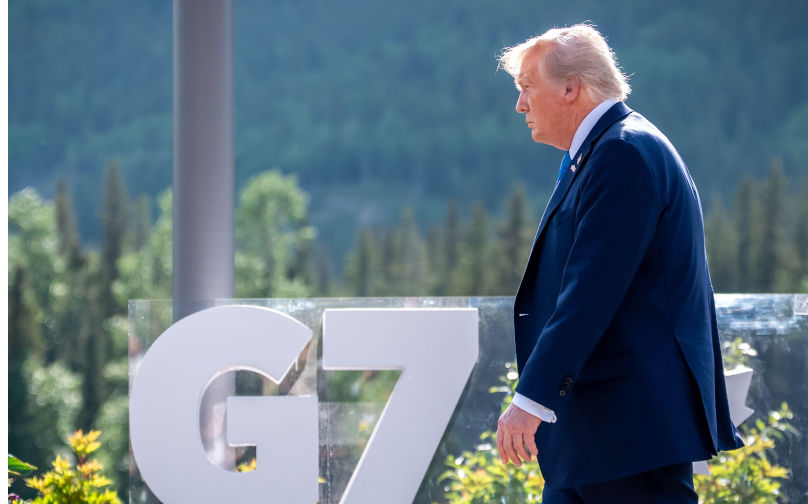Trump’s disruption in Canada leaves the G7 at a crossroads
June 24, 2025
It could have been worse – much worse. US President Donald Trump’s early exit from Kananaskis and the G7 Summit — that he declared was necessary to deal with the Israel–Iran war — left Canadian Prime Minister Mark Carney with his summit largely intact.
This was the first G7 hosted by Carney. While new to the prime ministership, he had earlier experience in high-level summitry as both the head of the Bank of Canada and the Bank of England. But hosting this G7 at Kananaskis was made highly sensitive with the return of Trump as US president – and with him, renewed questions about the United States’ role in the global order.
The G7 began as an informal grouping of major liberal democracies. Initially convened as the G6 — Britain, France, Germany, Italy, Japan and the United States — at Rambouillet in 1975, it became the G7 with Canada’s inclusion in 1976. Russia formally joined in 1998, but was suspended following its occupation of Crimea in 2014. In turn, Russia chose to exit the G7 in 2017, remaining with the G20 and BRICS.
At Kananaskis, Trump again suggested that he favoured a return to the G8. As he said to reporters before departing,“The G7 used to be the G8… I would say that was a mistake [for Russia to be forced out] because I think you wouldn’t have a war right now.”
What Trump forgets is that the G7 was always a group of like-minded states that promoted liberal democratic values and supported democratic policy actions. The G7 was once where the US worked with like-minded allies on major global issues, such as the Iran-Israel conflict. His parting criticism of French President Emmanuel Macron for the temerity of saying he left the summit to seek an Israel-Iran ceasefire underscores his contempt for the forum.
Carney did his best to maintain bilateral and group coherence. On the bilateral front, he announced early that Canada would achieve NATO’s 2% defence spending target five years earlier than originally projected. This was a “ shrewd and necessary move”, helping NATO secretary-general Mark Rutte confirm that all member states were expected to reach the alliance’s spending target by 2025.
Carney also invited leaders from Brazil, South Africa, India, the United Arab Emirates, South Korea, Mexico, Ukraine and Australia. While Ukrainian President Volodymyr Zelensky’s inclusion was tied to Ukraine-Russia sanctions, others hoped for one-on-one meetings with Trump. Carney, himself, hoped to minimise the time leaders spent together, allowing plenty of space for bilateral meetings and social interactions. In the end, though, Trump’s early departure left many leaders without the opportunity to make their case to Trump, notably on tariffs.
The immediate shadow over all these discussions was the various tariffs that Trump had imposed on the participants. Trump’s tariffs on steel and aluminium remain a pressing issue, for Canada and also for other countries. Though the Trump-Carney sit-down on the first day of the summit seemed constructive, no agreement was reached. More negotiating apparently needs to be done.
To avoid friction, Carney announced in advance that there would be no joint communique. The evident risk of Trump disagreeing led Canada to identify that there would only be a chair’s statement. Canada, as host, also issued six more statements – four of them signed off by the G7 leaders and two more signed by additional countries. The value of not requiring a joint communique was underscored when Trump initially refused to sign the statement on Israel-Iran, agreeing only after changes were made.
In the end, Carney outlined the summit’s priorities as “protecting our communities and the world, building energy security and accelerating the digital transition, and securing the partnerships of the future”.
Still, Trump’s pressing Russian membership underscores a deeper tension. If liberal democratic values are at the heart of the G7, reintegrating Russia is a non-starter. Suggestions to add liberal democratic states from the Indo-Pacific, like South Korea and Australia, have been promoted, but Trump 2.0 makes such initiatives unlikely. As for adding Global South participants, the larger grouping of democratic and rising Global South participants already exists with the G20.
US leadership has long been embedded in the G7, but with Trump, the group is seemingly unable to act purposefully and advance actions to meet the many challenges of global governance today. Key issues like climate change, financial institutional reform and debt distress have repeatedly been talked about, but that agenda is not going to be taken up with Trump 2.0.
What is left for the G7 may well be becoming a G6. But for this to occur, G7 members must be willing to act without the US. It is possible but it requires leaders to believe that they can act as an initiating coalition whether or not with Washington.
Otherwise, the G7 is likely to wander aimlessly for the next three years at least – and that would be a shame.
Republished from East Asia Forum, 22 June 2025
The views expressed in this article may or may not reflect those of Pearls and Irritations.
